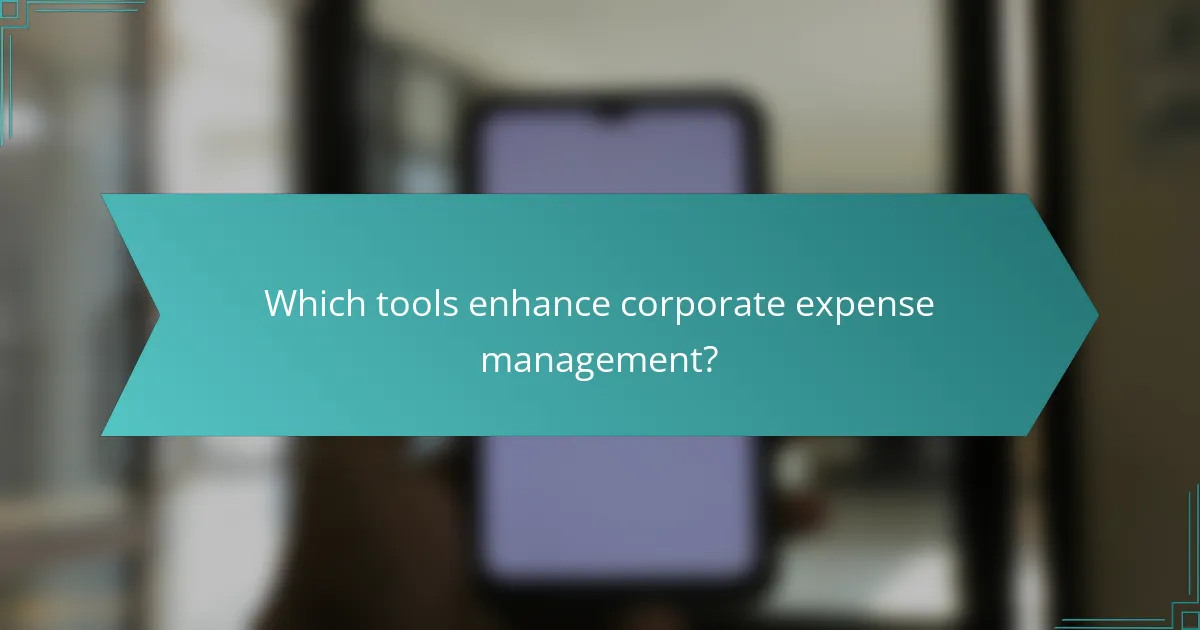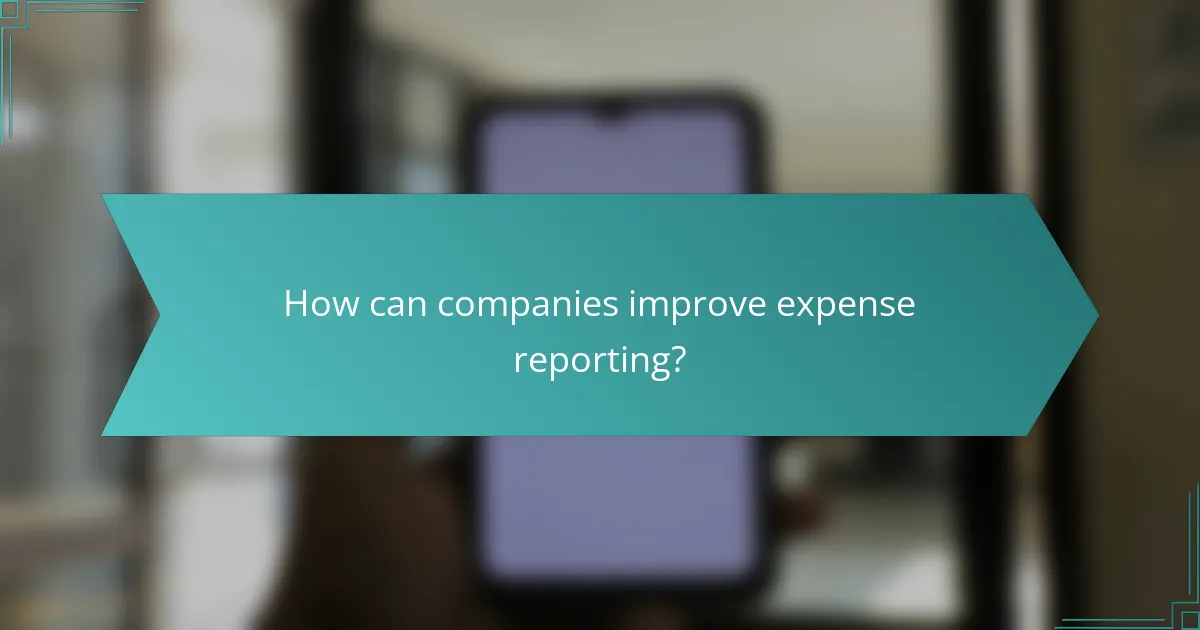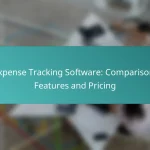Corporate expense management is crucial for maintaining financial health and operational efficiency within organizations. By employing effective techniques such as budgeting, utilizing expense tracking software, and conducting regular audits, companies can gain better control over their expenditures. Additionally, selecting the right tools tailored to specific needs can streamline processes and enhance visibility, ultimately leading to improved financial oversight.

What are effective techniques for corporate expense management?
Effective techniques for corporate expense management include budgeting and forecasting, utilizing expense tracking software, implementing employee training programs, enforcing policies, and conducting regular audits. These strategies help organizations control costs, improve financial visibility, and enhance overall efficiency.
Budgeting and forecasting
Budgeting and forecasting are essential for effective expense management as they provide a financial roadmap for the organization. By setting clear budgets, companies can allocate resources efficiently and anticipate future expenses based on historical data and market trends.
To create a robust budget, involve various departments to gather insights and ensure alignment with organizational goals. Regularly review and adjust the budget to reflect changes in business conditions, which can help avoid overspending.
Expense tracking software
Expense tracking software automates the process of recording and analyzing company expenditures. This tool enables real-time visibility into spending patterns, making it easier to identify areas for cost reduction and improve compliance with budgetary constraints.
When selecting expense tracking software, consider features such as integration with existing financial systems, user-friendly interfaces, and mobile access. Popular options include Expensify, Concur, and Zoho Expense, which can streamline expense reporting and approval workflows.
Employee training programs
Implementing employee training programs is crucial for ensuring that staff understand the company’s expense policies and procedures. Training can help reduce errors in expense reporting and promote accountability among employees.
Consider offering workshops or online courses that cover topics such as proper expense categorization, submission timelines, and compliance with company policies. Regular refresher courses can help keep employees informed about any changes in procedures or regulations.
Policy enforcement
Enforcing expense policies is vital for maintaining control over corporate spending. Clear policies should outline what expenses are reimbursable, the approval process, and the consequences of non-compliance.
To ensure adherence, communicate policies clearly and provide easy access to documentation. Regularly review and update policies to reflect changes in business needs or industry standards, and consider using automated systems to flag non-compliant submissions.
Regular audits
Conducting regular audits of expense reports is an effective way to identify discrepancies and ensure compliance with company policies. Audits can uncover fraudulent activities, errors, or areas where expenses exceed expectations.
Establish a schedule for audits, whether quarterly or biannually, and involve both internal and external auditors for a comprehensive review. Use audit findings to refine policies and improve training programs, ultimately enhancing the overall expense management process.

Which tools enhance corporate expense management?
Several tools can significantly improve corporate expense management by streamlining processes, enhancing visibility, and ensuring compliance. These tools help businesses track spending, automate approvals, and simplify reporting, ultimately leading to better financial control.
Expensify
Expensify is a popular expense management tool that automates the expense reporting process. Users can snap photos of receipts, and the software will extract relevant data, making it easy to track expenses in real-time.
This tool offers features like automatic mileage tracking and integration with accounting software, which can save time and reduce errors. Expensify also supports multi-currency transactions, making it suitable for international operations.
Concur
Concur is a comprehensive expense management solution that integrates travel and expense reporting. It allows users to book travel and manage expenses within a single platform, enhancing efficiency.
With Concur, businesses can enforce compliance with travel policies and gain insights through detailed reporting. Its mobile app enables users to manage expenses on the go, which is particularly useful for frequent travelers.
Zoho Expense
Zoho Expense is designed for small to medium-sized businesses, offering features like expense tracking, approval workflows, and reporting. Users can easily categorize expenses and generate reports to analyze spending patterns.
This tool also supports multi-currency transactions and integrates with other Zoho applications, providing a seamless experience for users already within the Zoho ecosystem. Its user-friendly interface makes it accessible for teams of all sizes.
QuickBooks
QuickBooks is primarily known for accounting but also offers robust expense management features. Users can track expenses, categorize them, and link them directly to invoices, simplifying financial management.
QuickBooks provides detailed financial reports that help businesses understand their spending habits. Its integration with banking systems allows for automatic transaction imports, reducing manual entry and potential errors.
Certify
Certify is an expense management tool that focuses on simplifying the expense reporting process. It offers features such as receipt capture, expense categorization, and approval workflows to streamline management.
Certify’s mobile app allows users to manage expenses from anywhere, making it ideal for remote teams. Additionally, it provides analytics to help businesses identify spending trends and optimize budgets effectively.

How to choose the right expense management software?
Choosing the right expense management software involves understanding your company’s specific needs and ensuring the software aligns with them. Key factors include company size, integration capabilities, user experience, and pricing models.
Assess company size and needs
Start by evaluating your company’s size and the complexity of its expense management processes. A small business may require basic features, while larger organizations might need advanced functionalities like multi-currency support and extensive reporting capabilities.
Consider the volume of expenses processed monthly and the number of users who will access the software. This assessment helps in selecting a solution that can scale as your business grows.
Evaluate integration capabilities
Integration with existing systems is crucial for seamless operations. Check if the expense management software can connect with your accounting, payroll, and ERP systems to streamline data flow and reduce manual entry.
Look for software that offers APIs or pre-built integrations with popular tools. This can save time and minimize errors, enhancing overall efficiency.
Consider user experience
User experience significantly impacts adoption rates. Choose software that is intuitive and easy to navigate, ensuring that employees can submit expenses without extensive training.
Consider features like mobile access and automated receipt scanning, which can simplify the process for users on the go. A positive user experience can lead to better compliance and more accurate expense reporting.
Review pricing models
Pricing models for expense management software can vary widely, from subscription-based fees to one-time purchases. Assess your budget and consider whether a monthly fee or a one-off cost is more feasible for your financial planning.
Look for transparent pricing structures that include all features, as hidden costs can lead to budget overruns. Some providers may offer tiered pricing based on the number of users or features, so evaluate which model aligns best with your company’s needs.

What are common challenges in corporate expense management?
Common challenges in corporate expense management include fraud and misuse, lack of employee compliance, data accuracy issues, and integration with existing systems. Addressing these challenges is crucial for maintaining financial integrity and optimizing expense processes.
Fraud and misuse
Fraud and misuse of corporate expenses can significantly impact a company’s bottom line. Employees may submit false claims or misuse company funds for personal expenses, leading to financial losses. Implementing strict policies and using expense management software with fraud detection features can help mitigate these risks.
Regular audits and employee training on ethical spending practices are also effective strategies. Companies should establish clear guidelines on what constitutes acceptable expenses to reduce ambiguity and discourage fraudulent behavior.
Lack of employee compliance
A lack of employee compliance with expense policies can hinder effective expense management. Employees may not fully understand the guidelines or may find them too cumbersome, leading to inconsistent reporting. To improve compliance, companies should simplify their expense reporting processes and provide clear, accessible training materials.
Incentivizing adherence to expense policies through rewards or recognition can also encourage compliance. Regularly communicating the importance of following these guidelines helps reinforce their significance within the corporate culture.
Data accuracy issues
Data accuracy is critical in corporate expense management, as errors can lead to incorrect financial reporting and budgeting. Inaccurate data may arise from manual entry mistakes or outdated information. Utilizing automated expense management tools can significantly reduce human error and improve data integrity.
Regularly reviewing and reconciling expense reports against receipts and bank statements is essential for maintaining accuracy. Companies should establish a routine for data verification to catch discrepancies early and ensure reliable financial records.
Integration with existing systems
Integrating expense management systems with existing financial software is often a challenge for organizations. Poor integration can lead to data silos, inefficiencies, and increased manual work. Choosing expense management solutions that offer seamless integration with popular accounting software can streamline processes and enhance data flow.
Before implementing a new system, companies should assess their current technology stack and identify potential compatibility issues. Engaging IT professionals during the selection process can help ensure a smoother integration and minimize disruptions to daily operations.

How can companies improve expense reporting?
Companies can enhance expense reporting by implementing streamlined processes, utilizing technology, and fostering a culture of accountability. Effective techniques include adopting automated tools, establishing clear guidelines, and regularly reviewing expenses for compliance and accuracy.
Implementing Automated Expense Management Tools
Automated expense management tools simplify the reporting process by allowing employees to submit expenses digitally. These tools often integrate with accounting software, reducing manual entry and minimizing errors. Popular options include platforms like Expensify, Concur, and Zoho Expense.
When selecting a tool, consider features such as mobile access, receipt scanning, and customizable approval workflows. These functionalities can significantly speed up the reimbursement process and enhance employee satisfaction.
Establishing Clear Policies and Guidelines
Clear policies and guidelines are essential for effective expense reporting. Companies should define what constitutes a reimbursable expense, set spending limits, and outline the documentation required for submissions. This clarity helps prevent misunderstandings and ensures compliance with company standards.
Regularly communicating these policies and providing training can further reinforce adherence. Consider creating a quick reference guide or checklist for employees to follow when submitting expenses.
Regular Review and Audit of Expenses
Conducting regular reviews and audits of expense reports helps identify patterns and potential issues. This practice can uncover discrepancies, such as duplicate submissions or non-compliant expenses, and allows for corrective actions to be taken promptly.
Establish a routine for reviewing expenses, such as monthly or quarterly audits. This not only ensures accuracy but also promotes a culture of accountability among employees regarding their spending habits.








